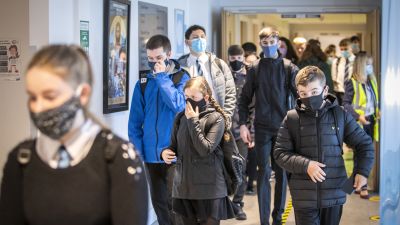Covid cases rising fastest among teenagers and young adults, ONS data reveals

Coronavirus infections rates are rising fastest among teenagers and young adults, new figures released by the Office for National Statistics reveal.
Data released on Friday shows there has been a rise in cases among children of secondary school age (school year 7 to 11), while the fastest rise has been among young adults of sixth form and university age.
The rise in the number of young people testing positive for coronavirus coincides with their return to school and university, where a number of students have been made to isolate following positive tests in shared accommodation.
A weekly report on coronavirus showed there has been 595 confirmed coronavirus clusters in schools across England within the past four weeks.
The majority of those clusters have taken place in secondary schools (252) or primary schools (216), while 53 have occurred in college or university settings.
Figures show there is around 70 Covid cases per 100,000 people aged between 10-19, compared to less than 20 per 100,000 of children aged five to nine.
There has been an increase in the percentage of school year 7 to 11 testing positive for Covid-19, up from less than 0.1% on August 26 to 0.3% on September 24.
This upward trajectory is more profound in young people aged school year 12 to age 24, rising from 0.1% on August 26 to 0.5% on September 24.
Despite a rise in cases among young adults, there is some limited evidence that rates may have levelled off in recent weeks for those of primary school age or below (age two years to school year 6). There has also been a steady fall in positive cases of people aged 25 to 34.
The report added there is "some limited evidence" to suggest the rate of infection may be levelling off following steep increases during August and September, and cautioned that it was "too early to say".
Figures show an estimated one in 500 people were infected in England between September 18 and 24.
This is an estimated 116,600 people in private households, which is the equivalent of around 0.21% of the population - up slightly on the previous estimate of 103,600 people – around 0.19% of the population – for September 13 to 19.
The report added "there is evidence of higher infection rates in the North West and North East, as well as Yorkshire and the Humber and London." The ONS found there were around 8,400 new cases per day across England from September 18 to 24, down on the 9,600 in the previous week.
However, Katherine Kent, co-head of analysis for the Covid-19 Infection Survey, said: “While the evidence suggests that the increase in new cases may be levelling off after a sharp rise in August and September, it is too early to be certain at this stage.”
Over the last six weeks, the study analysed almost 300,000 test swabs from randomly selected members of the public, whether they have symptoms or not.